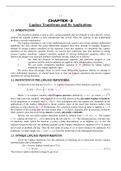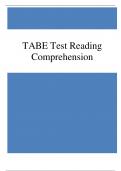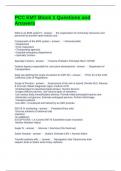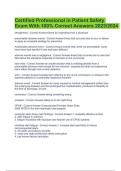- - 11 -
CHAPTER - 2
Laplace Transforms and Its Applications
2.1. INTRODUCTION:
The transform method is used to solve certain problems that are difficult to solve directly. In this
method the original problem is first transformed and solved. Then the solution to the transformed
problem is inverse transformed.
The Laplace transform is one of the mathematical tools used to solve linear ordinary differential
equations. We first convert the given differential equation from time domain to complex frequency
domain by taking Laplace transform of the equation. From this equation, we determine the Laplace
transform of the unknown variable. Finally, we convert this expression into time domain by taking
inverse Laplace transform. Laplace transform method of solving differential equations offers two
distinct advantages over classical method of problem solving, which are as follows:
1. We find out solution of homogeneous equation and particular integral in one
operation and the initial conditions are applied while taking Laplace transform.
2. We can easily manipulate algebraic equation in ‘s’ obtained by taking Laplace
transform, by simple algebraic rules.
We notice these advantages when we solve some differential equations. Before we attempt to
solve differential equations, we should know how to find out Laplace transform and inverse Laplace
transform of various functions.
2.2. DEFINITION OF THE LAPLACE TRANSFORMS:
Let there be a real function f(t) for t 0 . Laplace transform of this function is given by
L[ f (t )] F ( s ) e st f (t )dt ……………………………………….... (2.2.1)
0
Where ‘s’ is complex variable, called Laplace operator, defined by s j where j 1
and and are real variables. The equation (2.2.1) is also known as the one-sided Laplace transform,
as the integration is evaluated from t 0 to . This assumption does not impose any limitation on the
applications of the Laplace transform to linear systems, since in the usual time domain studies, time
reference is often chosen at t = 0. Furthermore, for a physical system when an input is applied at t = 0,
the response of the system does not start sooner than t = 0; that is, response does not precede excitation.
Such system is also known as being causal or simply physically realizable.
Strictly, the one sided Laplace transform should be defined from t 0 to t . The symbol
t 0 implies the limit of t 0 is taken from the left side of t 0 . This limiting process will take care
of situations under which the function f (t ) has a jump discontinuity or an impulse at t 0 . For the
subjects treated in this text, the defining equation of the Laplace transform in equation (2.2.1) is almost
never used in problem solving. Thus the fine point of using 0 or 0 never needs to be addressed. For
simplicity, we shall simply use t 0 or t t 0 ( 0) as the initial time in all subsequent discussions.
2.3. INVERSE LAPLACE TRANSFORMATION:
Given the Laplace transform F(s), the operation of obtaining f(t) is termed the inverse Laplace
transformation and is denoted by
f(t) = Inverse Laplace transform of F(s)
= L1[ F ( s )] ………………………………………………………..………...….. (2.3.1)
The inverse Laplace transform integral is given as
,- - 12 -
c j
1 st
f (t ) F ( s )e ds ………………………………………………….. (2.3.2)
2 j c j
Where, c is a real constant that is greater than the real parts of all the singularities of F(s).
Equation (2.3.2) represents line integral that is to be evaluated in the s-plane.
2.4. LAPLACE TRANSFORMS OF SOME IMPORTANT FUNCTIONS:
Unit–step function: Consider the unit-step function
f(t) = u(t)
with u(t) = 0 for t < 0
=1 for t ≥ 0
The Laplace transform of the above function
F(s) = Laplace transform of f(t)
st e st st
= u (t )e dt 1e dt
0 0 s 0
1 1 1
= (e .s e 0 ) (0 1) ……………………….. (2.4.1)
s s s
Exponential function: Consider the exponential function
f (t ) e at
The Laplace transform of the above function
F(s) = Laplace transform of f(t)
e at e st dt e ( a s ) t dt
0 0
e ( a s )t 1 1
……...……………………… (2.4.2)
a s 0 as sa
Sinusoidal functions: Consider the sinusoidal function
1 j t
f (t ) sin t , Now sin t ( e e j t )
2j
The Laplace transform of the above function
F(s) = Laplace transform of f(t)
1
sin t e st dt = (e jt e jt )dt
0 0
2j
1 1 1
2 ……………………….. (2.4.3)
2 j s j s j s 2
Ramp function: Consider the ramp function
f(t) = t for t > 0
=0 for t < 0
The Laplace transform of the above function
F(s) = Laplace transform of f(t)
te st dt t e st dt (e st dt )dt
0
(Integration by parts)
0
st
te st e e st 1 1
dt ( 0 0) 2 2 (0 1) 2 ….. (2.4.4)
s 0 0 s s 0 s s
, - - 13 -
Translated function: Consider the translated function
f1 (t ) f (t t 0 ) where t t 0
=0 where t t 0
The Laplace transform of the above function
F(s) = f1 (t )e st dt f (t t 0 )e s ( t t0 ) e st0 dt
0 0
Putting t t 0 , we have
dt
1 or dt d
d
Therefore, F1 ( s ) e st0 f ( )e s d e st0 F ( s ) ………………………………. (2.4.5)
t0
Where F(s) is the Laplace transform of f(t).
Unit pulse function: Consider the pulse function of unity height and width T, denoted by f(t,T) and as
shown in the figure below:
1
t
0 T
The Laplace transform of f (t , T ) is found by superposition of two step functions as shown in the
preceding figure. Thus,
1 e st 1
Lf (t , T ) Lu (t ) Lu (t T ) (1 e sT ) ……………….. (2.4.6)
s s s
1
Unit impulse function: The unit impulse function is the pulse of height and width T starting at t = 0
T
and considering T approaching zero. That is,
1
(t ) T lim 0 [u (t ) u (t T )]
T
Therefore, L [ ( t )] lim 1 (1 e sT )
T 0
T s
sT
se
T lim 0 (By L’Hospital rule)
s
=1 ………………….……….. (2.4.7)
2.5. IMPORTANT THEOREMS (OR PROPERTIES) OF LAPLACE TRANSFORM:
The applications of the Laplace transform in many instances are simplified by utilization of the
properties of the transform. These properties are presented by the following theorems, for which no
proofs are given here.
Theorem 1: Multiplication by a constant
Let k be a constant, and F(s) be the Laplace transform of f(t). Then
L[kf (t )] kF ( s )
CHAPTER - 2
Laplace Transforms and Its Applications
2.1. INTRODUCTION:
The transform method is used to solve certain problems that are difficult to solve directly. In this
method the original problem is first transformed and solved. Then the solution to the transformed
problem is inverse transformed.
The Laplace transform is one of the mathematical tools used to solve linear ordinary differential
equations. We first convert the given differential equation from time domain to complex frequency
domain by taking Laplace transform of the equation. From this equation, we determine the Laplace
transform of the unknown variable. Finally, we convert this expression into time domain by taking
inverse Laplace transform. Laplace transform method of solving differential equations offers two
distinct advantages over classical method of problem solving, which are as follows:
1. We find out solution of homogeneous equation and particular integral in one
operation and the initial conditions are applied while taking Laplace transform.
2. We can easily manipulate algebraic equation in ‘s’ obtained by taking Laplace
transform, by simple algebraic rules.
We notice these advantages when we solve some differential equations. Before we attempt to
solve differential equations, we should know how to find out Laplace transform and inverse Laplace
transform of various functions.
2.2. DEFINITION OF THE LAPLACE TRANSFORMS:
Let there be a real function f(t) for t 0 . Laplace transform of this function is given by
L[ f (t )] F ( s ) e st f (t )dt ……………………………………….... (2.2.1)
0
Where ‘s’ is complex variable, called Laplace operator, defined by s j where j 1
and and are real variables. The equation (2.2.1) is also known as the one-sided Laplace transform,
as the integration is evaluated from t 0 to . This assumption does not impose any limitation on the
applications of the Laplace transform to linear systems, since in the usual time domain studies, time
reference is often chosen at t = 0. Furthermore, for a physical system when an input is applied at t = 0,
the response of the system does not start sooner than t = 0; that is, response does not precede excitation.
Such system is also known as being causal or simply physically realizable.
Strictly, the one sided Laplace transform should be defined from t 0 to t . The symbol
t 0 implies the limit of t 0 is taken from the left side of t 0 . This limiting process will take care
of situations under which the function f (t ) has a jump discontinuity or an impulse at t 0 . For the
subjects treated in this text, the defining equation of the Laplace transform in equation (2.2.1) is almost
never used in problem solving. Thus the fine point of using 0 or 0 never needs to be addressed. For
simplicity, we shall simply use t 0 or t t 0 ( 0) as the initial time in all subsequent discussions.
2.3. INVERSE LAPLACE TRANSFORMATION:
Given the Laplace transform F(s), the operation of obtaining f(t) is termed the inverse Laplace
transformation and is denoted by
f(t) = Inverse Laplace transform of F(s)
= L1[ F ( s )] ………………………………………………………..………...….. (2.3.1)
The inverse Laplace transform integral is given as
,- - 12 -
c j
1 st
f (t ) F ( s )e ds ………………………………………………….. (2.3.2)
2 j c j
Where, c is a real constant that is greater than the real parts of all the singularities of F(s).
Equation (2.3.2) represents line integral that is to be evaluated in the s-plane.
2.4. LAPLACE TRANSFORMS OF SOME IMPORTANT FUNCTIONS:
Unit–step function: Consider the unit-step function
f(t) = u(t)
with u(t) = 0 for t < 0
=1 for t ≥ 0
The Laplace transform of the above function
F(s) = Laplace transform of f(t)
st e st st
= u (t )e dt 1e dt
0 0 s 0
1 1 1
= (e .s e 0 ) (0 1) ……………………….. (2.4.1)
s s s
Exponential function: Consider the exponential function
f (t ) e at
The Laplace transform of the above function
F(s) = Laplace transform of f(t)
e at e st dt e ( a s ) t dt
0 0
e ( a s )t 1 1
……...……………………… (2.4.2)
a s 0 as sa
Sinusoidal functions: Consider the sinusoidal function
1 j t
f (t ) sin t , Now sin t ( e e j t )
2j
The Laplace transform of the above function
F(s) = Laplace transform of f(t)
1
sin t e st dt = (e jt e jt )dt
0 0
2j
1 1 1
2 ……………………….. (2.4.3)
2 j s j s j s 2
Ramp function: Consider the ramp function
f(t) = t for t > 0
=0 for t < 0
The Laplace transform of the above function
F(s) = Laplace transform of f(t)
te st dt t e st dt (e st dt )dt
0
(Integration by parts)
0
st
te st e e st 1 1
dt ( 0 0) 2 2 (0 1) 2 ….. (2.4.4)
s 0 0 s s 0 s s
, - - 13 -
Translated function: Consider the translated function
f1 (t ) f (t t 0 ) where t t 0
=0 where t t 0
The Laplace transform of the above function
F(s) = f1 (t )e st dt f (t t 0 )e s ( t t0 ) e st0 dt
0 0
Putting t t 0 , we have
dt
1 or dt d
d
Therefore, F1 ( s ) e st0 f ( )e s d e st0 F ( s ) ………………………………. (2.4.5)
t0
Where F(s) is the Laplace transform of f(t).
Unit pulse function: Consider the pulse function of unity height and width T, denoted by f(t,T) and as
shown in the figure below:
1
t
0 T
The Laplace transform of f (t , T ) is found by superposition of two step functions as shown in the
preceding figure. Thus,
1 e st 1
Lf (t , T ) Lu (t ) Lu (t T ) (1 e sT ) ……………….. (2.4.6)
s s s
1
Unit impulse function: The unit impulse function is the pulse of height and width T starting at t = 0
T
and considering T approaching zero. That is,
1
(t ) T lim 0 [u (t ) u (t T )]
T
Therefore, L [ ( t )] lim 1 (1 e sT )
T 0
T s
sT
se
T lim 0 (By L’Hospital rule)
s
=1 ………………….……….. (2.4.7)
2.5. IMPORTANT THEOREMS (OR PROPERTIES) OF LAPLACE TRANSFORM:
The applications of the Laplace transform in many instances are simplified by utilization of the
properties of the transform. These properties are presented by the following theorems, for which no
proofs are given here.
Theorem 1: Multiplication by a constant
Let k be a constant, and F(s) be the Laplace transform of f(t). Then
L[kf (t )] kF ( s )











